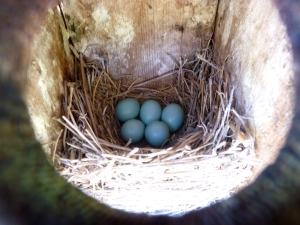By Nick Olivier, Communications Intern
Jim Marshall doesn’t claim to be an ornithologist (studier of birds) or even an expert birder (bird watcher). He’s just a guy who loves the outdoors and appreciates its wildlife. One day in 2007, he was surprised to see a few bluebirds along the Trinity Trails and Trinity River in Fort Worth. Having owned a feed store, he reached out to Streams and Valleys for help receiving permission from the city to put up manmade nest boxes along the trails. Four years later, the bluebird population is thriving, to the benefit of the birds and all users of the Trinity Trails.
I met Jim one weekday morning to follow him as he checked on the dozen or so nest boxes lined along a 3.5-mile stretch of the Trinity Trails between Rogers Road and Bryant Irvin Road. I expected to see few bluebirds and to have a hard time capturing them with my camera. I figured the closest I would get to seeing bluebirds would be their eggs inside the nest boxes. I quickly realized that the Bluebird Project was farther along than I thought. An estimated total of 70 fledglings hatched during the 2010 season alone.
Apparently, I picked a good day to join Jim on his check-up. We saw bluebirds flying around just about every nest box we stopped at. Usually, each nest box was accompanied by a male and female looking after and feeding their young. Two different bike riders, one stranger and one acquaintance, stopped to tell Jim that they appreciated his work and enjoyed seeing the bluebirds. Jim’s rounds included stops to give the bluebirds treats (worms), label a newer nest box and check in on some chicks nearly about to fledge (leave the nest for good).
Bluebirds 101: As with most birds, male bluebirds are more brightly colored than their female counterparts. The males are bright blue with burnt orange chests while the females are lighter blue mixed with brown. Bluebirds differ from blue jays in that bluebirds have orange chests and blue jays have a white stripe on their backs. Bluebirds eat insects and the parents bring the food to their babies. Bluebirds eggs are preyed upon by hawks, snakes and fire ants. Bluebirds are territorial up to about 100 yards and they nest in notches (holes) in trees. The nest boxes are meant to recreate these notches.
Click HERE to see the many more photos of the bluebirds, including fledglings.
Click HERE to see video of the bluebirds in flight, enjoying a worm and more.
Have you seen the bluebirds along the Trinity Trails? What other birds would you like to see on your next bike ride or jog? Do you wish there were more people like Jim working to make the trails a more scenic environment?






Leave a comment